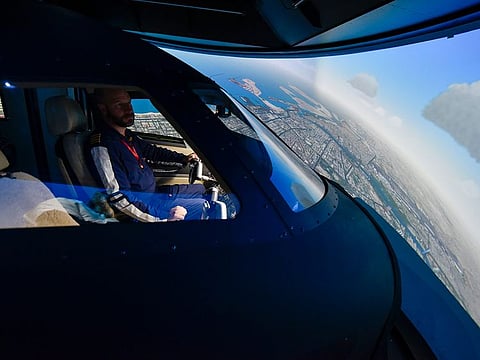As UAE’s airline job hires, salaries soar, aviation training is turning into big business
As airlines speed up intake new aspirants are getting some serious training

Dubai: In the UAE, airlines are recruiting like never before - pilots, cabin crew, engineers, IT personnel. Name any position and chances are an airline will be busy filling it up with the right candidate. Or more of them.
And salaries too are soaring, as airline report record travel demand through summer.
“If cabin crew positions offered Dh8,000 in 2019, full-service carriers now offer salaries ranging from Dh9,000-Dh10,500,” said Dr Sathya Menon, CEO of Blue Ocean Corporation, comparing 2019 wage levels to now.
In 2019, low-cost carriers were offering Dh6,000, but today that’s Dh8,000.

This demand for trained/skilled personnel for airlines and support businesses will not run dry any time soon. Gulf-based airlines are into their own hiring spree, notably in Saudi Arabia.
All of which is creating a boom time for aviation training opportunities in the UAE and Gulf.
Australia’s pilot training group, Ansett Aviation Training, opened a new facility in Dubai earlier this year. Mark Delany, CEO of Ansett Aviation Training, said the company is looking to provide pilot training services for aircraft operators not only from the Middle East but Africa and Asia.
In Saudi Arabia, the Prince Sultan Aviation Academy ordered six additional simulators to grow their training capacity, specifically to tap for post-pandemic demand

The UAE is well-positioned to expand its aviation training capabilities to meet the rapidly growing demand for professionals from local, regional, and international airlines. With the global commercial aeroplane fleet expected to double by 2042,
The US aircraft maker Boeing forecasts the Middle East region will need ‘at least’ 58,000 pilots by 2042. Add on another 58,000 technicians and 99,000 new cabin crew, and one can see why industry is focussing on adding state-of-the-art training capacity. “New aviation professionals need to be trained and released into service after many were forced to leave post-2019,” said Mark Kammer, Operations Director at Dynamic Advanced Training, an independent cabin crew training centre in Dubai. The company trains cabin crew for over 60 airlines - but operations need to be ramped up.
While the UAE already has a sizeable capacity for ‘steady-state’ training operations, there may be a shortage of specific training devices (depending on the type of training needed).
The region’s aviation industry, especially UAE carriers, are enticing workers with a 5-10 per cent salary increase compared to last year.
Common accreditation for aviation training?
The wold’s civil aviation authorities need to introduce a single standard for safety licenses and certifications, say industry insiders.
“One of the most complicated training issues is getting training centres certified in one country to be accepted or recognised by civil aviation authorities in another,” said Kammer. “It is expensive, bureaucratic and time-consuming. After all, if we can take off in one country and land in another and return, wouldn’t it be progressive if the certifications, licenses, accreditations were also mutually accepted?
“I believe there is room for improvement in this area and that the UAE government and its aviation authorities must continue pushing for this.”
According to Bilal Tahboub, co-founder and Training Director at Dynamic Advanced Training, said a common accreditation can contribute to the global standardization of aviation training.
Not to forget that General Civil Aviation Authority (GCAA) is working closely to align with European Union Aviation Safety Agency (EASA) and International Civil Aviation Organization (ICAO) complianceBilal Tahboub
“Meeting these global standards will make it easier for graduates to obtain recognition from other aviation boards. The UAE could also negotiate and sign reciprocal recognition agreements with other countries or aviation boards to recognise certifications obtained in the UAE.”
Regional hub for global airlines
Industry sources believe that the UAE has positioned itself to train to meet its local and international demand. With numerous direct flights from major airports by various airlines, the UAE and its centres can take on the task of training a new intake of pilots, cabin crew, engineers and technicians, “The government has identified the aviation sector as a vital contributor to the economy, and as such, they continue to support initiatives and investments into the wider aerospace industry,” said Kammer.
Obvious examples are Dubai South, which focuses on an aviation and logistics ecosystem, and the opening of Abu Dhabi’s Midfield terminal by the end of this year. “Emirates Flight Training Academy (EFTA) has ordered additional aircraft and has over 250 pilots in training,” said Maximilian Buerger, Managing Director of pilot training platforms AFM.aero and Aviationfly.com. “Emirates has also invested $135 million to build a new pilot training centre.”
And there will be more…
Sign up for the Daily Briefing
Get the latest news and updates straight to your inbox







